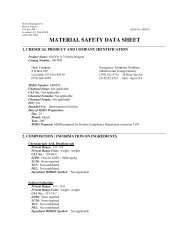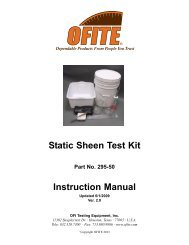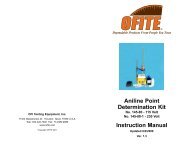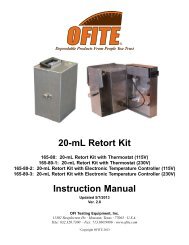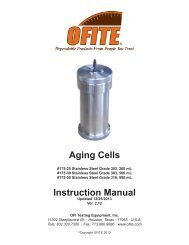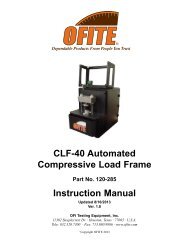Instructions - OFI Testing Equipment, Inc.
Instructions - OFI Testing Equipment, Inc.
Instructions - OFI Testing Equipment, Inc.
You also want an ePaper? Increase the reach of your titles
YUMPU automatically turns print PDFs into web optimized ePapers that Google loves.
<strong>OFI</strong> <strong>Testing</strong> <strong>Equipment</strong> – 146-00 <strong>Instructions</strong> – Workover and Completion Fluids Test Kit Page 14 of 17<br />
A. Add at least 1.0 mL of sample to the Beaker.<br />
If the filtrate is colorless or is only slightly colored, omit steps B - E.<br />
B. Add 10.0 ml of Sodium Hypochlorite solution and mix.<br />
C. Add 1.0 ml of Glacial Acetic Acid and mix.<br />
D. Boil the sample for 5 minutes and maintain the sample volume by adding distilled water as required<br />
during boiling. Boiling removes excess Chlorine and this may be verified by immersing a strip of Ph<br />
paper in the sample. If the paper is bleached white, continue boiling. A sufficiently boiled sample will<br />
have a pH of 5.0.<br />
E. Cool the sample and wash the sides of the beaker with distilled water.<br />
F. With distilled water, dilute the sample to approximately 50 ml.<br />
G. Add 10 to 15 ml of Calcium Buffer solution, or sufficient Buffer solution to produce a pH of 12 - 13.<br />
H. Optional: The presence of soluble Iron may interfere with the endpoint determination. If this is<br />
suspected, a mixture of Triethanolamine: Tetraethylenepentamine : Water (1:1:2 by volume) is a<br />
suitable masking agent.<br />
I. Add sufficient Calver ® II Indicator powder (0.1 to 0.2 grams) to produce a pink to wine-red color if<br />
Calcium is present. Too much indicator will obscure the endpoint. Note: Adding several drops of<br />
Methyl Orange Indicator solution may improve the visibility of the endpoint.<br />
J. While stirring, titrate with Hardness Titration solution (EDTA), to the end point. Calcium indicators<br />
produce a Red-to-Blue change and the endpoint is best described as that point where additional Titration<br />
solution will produce no further Red-to-Blue color change. The Titration solution volume will be used<br />
in the calculation procedure.<br />
3. Using the 1 ml pipette, add 1.0 ml of the original undiluted mud filtrate to the titration dish. Titrate with<br />
EDTA titration solution to the calcium endpoint, as above. Call this volume EDTA V f .<br />
4. Retort the whole mud. Determine the volume fraction of water in the mud by using the volume percent of water<br />
from the liquid and solids determination based upon the following equation.<br />
Volume Fraction of Water, F w =<br />
Volume Percent Water<br />
100<br />
Calculation:<br />
Total Calcium Sulfate, lb/bbl = 2.38 ( EDTA V t )<br />
The excess undissolved Calcium Sulfate content of the mud in pounds per barrel may be calculated as follows:<br />
Excess Calcium Sulfate, lb/bbl = 2.38 (EDTA V t) – 0.48 [EDTA V f x (F w )]<br />
Procedure:<br />
MAGNESIUM CONTENT<br />
The Hardness Titration test and the Calcium Titration test must be performed first.<br />
The total milliliters of Versenate Titration solution (EDTA), 1 mL = 400 mg/L Ca ++ used in the determination of total<br />
hardness, minus the milliliters of Versenate Titration solution (EDTA) used in the determination of calcium ion, times<br />
243 equals the mg/L of Magnesium.<br />
<strong>OFI</strong>TE • 11302 Steeplecrest Dr. • Houston, TX 77065 USA • Phone (832) 320-7300 • http://www.ofite.com<br />
Version 1.1<br />
Date 03-04-03



